WSIO Indicator Data Library
Watershed Index Online has been renamed to the Restoration and Protection Screening (RPS) Indicator Database. This webpage is no longer maintained. Visit the EPA RPS website for up-to-date information and resources to support strategic planning of priority waters and watersheds.
Data Tables, Services and Downloads
Regional HUC12 and HUC8 Indicator Data
One route for users to obtain watershed indicator data from WSIO is through creating and downloading a custom WSIO tool with user-selected data for their area of interest. WSIO indicator data tables containing all active WSIO indicators are also available for download below. The lower 48 states' currently available HUC12 and HUC8 indicator data are split into ten data tables that correspond with EPA Regions 1 through 10. Note that HUC12s and HUC8s that straddle the borders between two regions appear in both regional tables. Each regional data table is an Excel .xlsx file containing approximately 430 watershed indicators compiled at the HUC12 and HUC8 scale. Metadata are included in each file.
HUC12 Scale Indicator Data by EPA Region - Updated April 2023
- WSIO HUC12 Indicator Data for EPA Region 1 (includes CT, ME, MA, NH, RI, VT) (xlsx)
- WSIO HUC12 Indicator Data for EPA Region 2 (includes NJ, NY) (xlsx)
- WSIO HUC12 Indicator Data for EPA Region 3 (includes PA, WV, VA, MD, DE, DC) (xlsx)
- WSIO HUC12 Indicator Data for EPA Region 4 (includes KY, TN, NC, SC, MS, AL, GA, FL) (xlsx)
- WSIO HUC12 Indicator Data for EPA Region 5 (includes IL, IN, MN, MI, OH, WI) (xlsx)
- WSIO HUC12 Indicator Data for EPA Region 6 (includes TX, NM, AR, OK, LA) (xlsx)
- WSIO HUC12 Indicator Data for EPA Region 7 (includes KS, NE, IA, MO) (xlsx)
- WSIO HUC12 Indicator Data for EPA Region 8 (includes CO, WY, UT, ND, SD, MT) (xlsx)
- WSIO HUC12 Indicator Data for EPA Region 9 (includes CA, AZ, NV) (xlsx)
- WSIO HUC12 Indicator Data for EPA Region 10 (includes WA, OR, ID) (xlsx)
HUC8 Scale Indicator Data by EPA Region - Updated May 2020
- WSIO HUC8 Indicator Data for EPA Region 1 (includes CT, ME, MA, NH, RI, VT) (xlsx)
- WSIO HUC8 Indicator Data for EPA Region 2 (includes NJ, NY) (xlsx)
- WSIO HUC8 Indicator Data for EPA Region 3 (includes PA, WV, VA, MD, DE, DC) (xlsx)
- WSIO HUC8 Indicator Data for EPA Region 4 (includes KY, TN, NC, SC, MS, AL, GA, FL) (xlsx)
- WSIO HUC8 Indicator Data for EPA Region 5 (includes IL, IN, MN, MI, OH, WI) (xlsx)
- WSIO HUC8 Indicator Data for EPA Region 6 (includes TX, NM, AR, OK, LA) (xlsx)
- WSIO HUC8 Indicator Data for EPA Region 7 (includes KS, NE, IA, MO) (xlsx)
- WSIO HUC8 Indicator Data for EPA Region 8 (includes CO, WY, UT, ND, SD, MT) (xlsx)
- WSIO HUC8 Indicator Data for EPA Region 9 (includes CA, AZ, NV) (xlsx)
- WSIO HUC8 Indicator Data for EPA Region 10 (includes WA, OR, ID) (xlsx)
HUC12 and HUC8 Indicator Metadata
This Excel .xlsx file contains indicator names, definitions and data source information for all WSIO HUC12 and HUC8 indicators. It is the same metadata file that appears in each of the downloadable WSIO data tables. Some of the most commonly used datasets are available as map services from this site, as described below. A map service makes maps, features, and attribute data available online and can be used in a variety of applications.
Note: EPA recommends reaching out to the Healthy Watersheds Team at [email protected] for consult with respect to state-specific variability in data completeness and quality.
Key Datasets Available as Map Services and Data Downloads
Some of the most frequently used WSIO geospatial datasets are available as map services and data downloads below. These are national-scale GIS datasets, not tabular indicator data as above.
- HUC12 WSIO Indicator Service (see also the Watershed Index Online Web Service Guide (pdf) for instructions on using the web service)
- WSIO Geodatabase with Hydrologic Unit Code (HUC12) polygons
- Conterminous US Watershed Hydrologic Unit Code (HUC12 and HUC8) Boundary Layers
- Water Mask
- Hydrologically-Connected Zone
- Riparian Zone
- Wetness Index
Conterminous US Watershed Hydrologic Unit Code (HUC12 and HUC8) Boundary Layers
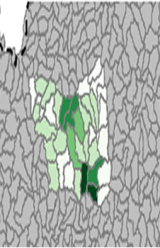
This is the exact version of the HUC12 boundaries used in WSIO indicator compilation, offered here because HUC12 boundaries available through other sites sometimes undergo minor revisions without notice. This dataset is consistent with the "WBD Snapshot" version of HUC12 boundaries that was integrated with the National Hydrography Dataset (NHD) Plus version 2 nationally, and is a common source used by most EPA water projects involving geospatial watershed data. The HUC8 layer is fully consistent with the HUC12 snapshot because it was derived directly from it by dissolving interior HUC12 boundary lines.
Water Mask
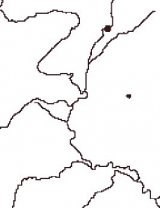
This dataset was developed using grid analysis to combine surface water features (rivers, lakes, reservoirs, estuaries, wetlands, oceans) of the National Land Cover Dataset (NLCD) and the 1:100,000 scale National Hydrography Dataset (NHD) Plus version 2 (which includes mapped point, linear and areal surface water features). The combination of these two datasets represents surface waters of all kinds and is referred to as the Water Mask.
Hydrologically-Connected Zone
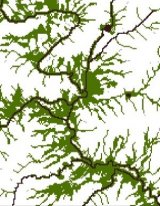
The Hydrologically Connected Zone (HCZ) is determined using grid analysis to combine surface water features of the National Land Cover Dataset (NLCD) and the 1:100,000 scale National Hydrography Dataset (NHD) Plus version 2 with areas contiguous to surface water that also have a wetness index value of 550 or greater. The combination of these three datasets represent the Hydrologically Connected Zone (HCZ).
Riparian Zone
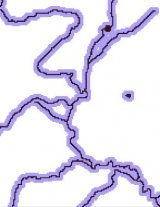
The Riparian Zone (RZ) is determined using grid analysis of an approximate 100 meter buffer placed around the combined surface water features of the National Land Cover Dataset (NLCD) and the 1:100,000 scale National Hydrography Dataset (NHD) Plus version 2. The combination of these two datasets and all cells with a distance of 108 meters or less from surface water are included in the RZ.
Wetness Index
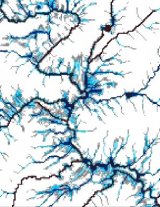
The Wetness Index is a Computed Topographic Index (CTI) derived from the National Hydrography Dataset Plus flow accumulation and slope of the Digital Elevation Model using the equation: grid wet_ndx = 100*(ln (flow accumulation/tan(slope)) + 3x3 mean of ln (flow accumulation/tan(slope))/2. This information was used to identify areas in the landscape likely to be wet. Values greater than 800 have been determined to represent areas which are usually wet. Due to exceptionally large size this dataset cannot be offered for download on this site.
